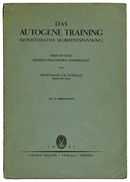Johannes Heinrich Schultz
Johannes Heinrich Schultz (June 20, 1884 – September 19, 1970) was a German psychiatrist and an independent psychotherapist. Schultz became world famous for the development of a system of self-hypnosis called autogenic training.
Life
He studied medicine in Lausanne, Göttingen (where he met Karl Jaspers) and Breslau. He earned his doctorate from Göttingen in 1907. After receiving his medical license in 1908, he practiced at the polyclinic at the Medical University Clinic at Göttingen until 1911. Afterwards he worked at the Paul-Ehrlich Institute in Frankfurt, at the insane asylum at Chemnitz and finally at the Psychiatric University Clinic at Jena under Otto Binswanger, where he earned his habilitation in 1915.
During the First World War, he served as director of a sanitorium in Belgium. In 1919 he became a professor of Psychiatry and Neuropathology at Jena. In 1920 he became Chief Doctor and scientific leader at Dr. Heinrich Lahmann's sanatorium Weisser Hirsch in Dresden. In 1924, he established himself as a psychiatrist in Berlin.
From 1925-26 he was a member of the founding committee for the first General Doctors' Congress for Psychotherapy, board member of the General Medical Society for Psychotherapy (established in 1927). From 1928 he advised the organization's newsletter, and after 1930 he co-edited (with Arthur Kronfeld and Rudolf Allers) the journal, now named the Zentralblatt für Psychotherapie.[1] In 1933 he became a board member of the renamed German Medical Society for Psychotherapy under Matthias Heinrich Göring and from 1936 under this vice-director a board member of the German Institute for Psychological Research and Psychotherapy (Deutsches Institut für psychologische Forschung und Psychotherapie) as well as director of the polyclinic.
From 1933 Schultz wrote a relationship guidebook.[2] - with very liberal views. There he propagated the "extermination" of handicapped people ("Action T4")[3] and persecution of homosexual men was part of his activity at the Göring Institute. Schultz believed that homosexuality was hereditary and curable. On the one hand the institute tried to cure homosexuals,[4] while on the other Schultz led a commission that compelled those suspected of homosexuality to have intercourse with female prostitutes. The "guilty" were transported to concentration camps.[5]
In 1956, he became editor of the journal Psychotherapie, and in 1959 founder of the German Society for Medical Hypnosis (Deutschen Gesellschaft für ärztliche Hypnose).
His most famous achievement was the development of autogenic training, that was based on the hypnosis research and self-experimentation. It was first publicly put forward in 1926 as "autogenic organ exercises," and received its current name in 1928. The program uses daily practice sessions of visualizations that are designed to help the practitioner achieve deep relaxation.
Writings



- (1915) "Neue Wege und Ziele der Psychotherapie" Ther. Monatshefte 29, pp. 443–450 (habilitation thesis).
- (1919) "Die seelische Krankenbehandlung (Psychotherapie)." Ein Grundriß für Fach- und Allgemeinpraxis. Jena: Fischer, seven editions. Stuttgart: Thieme, 1958.
- (1921) "Psychoanalyse und ihre Kritik." In: Adam, C. (ed.): Die Psychologie und ihre Bedeutung für die ärztliche Praxis. Eight editions. Jena: Fischer.
- (1925) "Schicksalsstunde der Psychotherapie." In: Moll, Albert (ed.): Abh. Gebiet. Psychother. med. Psychol. 1.
- (1927) "Die Einigungsbestrebungen in der Psychotherapie." In: Eliasberg, Wladimir (ed.): Bericht über den I. Allgemeinen Kongreß für Psychotherapie in Baden-Baden. 17.-19. April 1926. Halle: Carl Marhold Verlagsbuchhandlung, pp. 241–252.
- (1932) "Das Autogene Training (konzentrative Selbstentspannung)." Versuch einer klinisch-praktischen Darstellung. Leipzig: Thieme, many editions.
- (1935) "Hypnose-Technik." Praktische Anleitung zum Hypnotisieren für Ärzte. Jena: Fischer.
- (1935) Ubungsheft fur das Autogene Training (konzentrative Selbstentspannung). Leipzig: Thieme, many editions.
- (1936) "Neurose Lebensnot ärztliche Pflicht." Klinische Vorlesungen über Psychotherapie für Ärzte und Studierende. Leipzig: Thieme.
- (1940) "Geschlecht - Liebe - Ehe." Die Grundtatsachen des Liebes- und Geschlechtslebens in ihrer Bedeutung für Einzel- und Volksdasein. Munich: Reinhardt, seven editions.
- (1941) Die seelische Gesunderhaltung unter besonderer Berücksichtigung der Kriegsverhältnisse. E.S. Mittler & Sohn, Berlin
- (1951) Bionome Psychotherapie. Stuttgart: Thiema.
- (1952) "Organstörungen und Perversionen im Liebesleben." Bedeutung, Entstehung, Behandlung, Verhütung. Munich: Reinhardt.
- (1952) "Psychotherapie." Leben und Werk großer Ärzte. Stuttgart: Hippokrates.
- (1955) "Grundfragen der Neurosenlehre." Aufbau und Sinn-Bild. Propädeutik einer medizinischen Psychologie. Stuttgart: Thieme.
- (1964) Lebensbilderbuch eines Nervenarztes - Jahrzehnte in Dankbarkeit. Stuttgart: Thieme, second edition 1971.
Notes
- ↑ Geschichte der Psychotherapie in Deutschland im 20. Jahrhundert: Die Allgemeine Ärztliche Zeitschrift für Psychotherapie und psychische Hygiene
- ↑ u.a. Geschlecht–Liebe–Ehe. Ernst Reinhardt, München 1940
- ↑ Dagmar Herzog: Sex After Fascism. Memory and Morality in Twentieth-Century Germany. Princeton University Press 2005, ISBN 0-691-11702-0, S. 35; Geoffrey Cocks: Psychotherapy in the Third Reich. The Göring Institute. Transaction 1997, ISBN 1-56000-904-7, S. 235.
- ↑ James E. Goggin, Eileen Brockman Goggin: Death of a “Jewish Science”. Psychoanalysis in the Third Reich. Purdue University Press 2001, ISBN 1-55753-193-5, S. 120; Florence Tamagne: A history of homosexuality in Europe. Algora 2006, ISBN 0-87586-356-6, S. 385.
- ↑ Angelika Hager, Sebastian Hofer: Sex unterm Hakenkreuz. Das Lustverständnis der Nationalsozialisten in der Wissenschaft. In: Profil 22/08.
References
- Udo Busso Künzel, "Ich bin ganz ruhig": Psychoanalyse und Politik in den Publikationen des Begründers des Autogenen Trainings, Johannes Heinrich Schultz, Frankfurt am Main, Univ., Diss., 1998
- Christian Meurer: Wunderwaffe Witzkanone. Heldentum von Heß bis Hendrix. Oktober-Verlag, Münster 2006, ISBN 978-3-938568-01-9 (includes biographical essay on Schultz)
- Eberhard J. Wormer. "Schultz, Johannes." Neue deutsche Biographie / herausgegeben von der Historischen Kommission bei der Bayerischen Akademie der Wissenschaften. Vol. 23. Berlin: Duncker & Humblot, Berlin 2007, p. 700f.
External links
- (German) Works by Schultz in the German National Library
- (German) Critical article by Maja Langsdorff in the Stuttgarter Zeitung
- Schultz at www.whonamedit.com
|